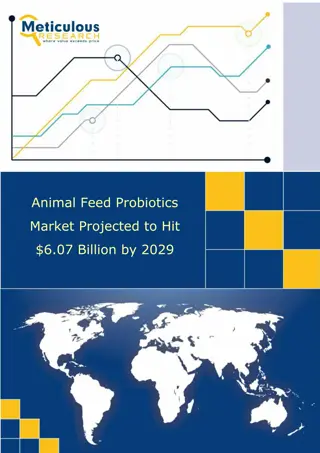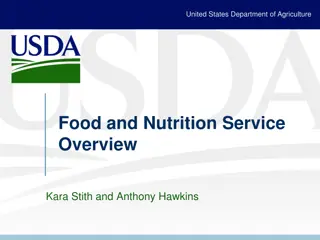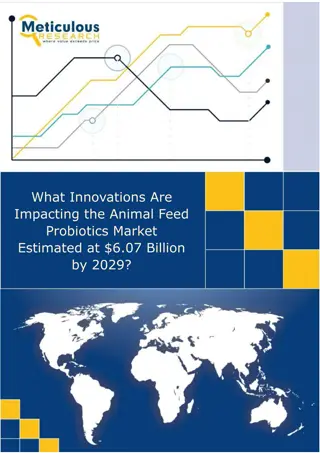Understanding the Role of Probiotics in Human Nutrition
Probiotics are live microorganisms that provide health benefits when consumed in adequate amounts. They should be safe, stable, nonpathogenic, and capable of various beneficial actions such as enhancing gut integrity, detoxifying, and modulating the immune system. Probiotics have a positive impact on human health by improving gut microecology, reducing infection risks, aiding digestion, detoxifying carcinogens, and enhancing immunity. To become a probiotic, microorganisms undergo isolation, tolerance testing, adherence studies, and target population designation. Various tests, including in vitro and in vivo assessments, are conducted to confirm their probiotic properties. Probiotics are utilized in human nutrition for their diverse health-promoting effects.
Download Presentation

Please find below an Image/Link to download the presentation.
The content on the website is provided AS IS for your information and personal use only. It may not be sold, licensed, or shared on other websites without obtaining consent from the author. Download presentation by click this link. If you encounter any issues during the download, it is possible that the publisher has removed the file from their server.
E N D
Presentation Transcript
PROBIOTICS IN HUMAN NUTRITION Agnieszka Chlebicz Katarzyna li ewska
What are probiotics? Live Live microorganisms which when administered in adequate amount adequate amount confer a health benefits on health benefits on the host the host r d a: [2, 11]
What they should be like? Generally Recognized As Safe (GRAS)/ Qualified Presumption of Safety (QPS) Isolated from safe environment Genetically stable Nonpathogenic Resistant o bile acids and low pH Adhesive to epithelial cells Pathogens antagonists r d a: [1, 7]
What probiotics can do? Enhacement of mucosla barrier integrity Detoxification properties Antimicrobial effect Immune modulation Synthesizing antmicrobial products Mucin production regulation Activation of lymphocytes Absorption Proper tight junction proteins expresion Production of antibodies Competitive exclusion Metabolism Stimulation of cells involved in innate and adaptive immunity r d a: [3, 4, 6]
Impact of probiotics on human health Altered GI tract microecology Inhibit pathogen growth and translocation. Reduce risk of infection from common pathogens (Salmonella, Shigella) Improve digestion of lactose and reduce intestinal bloating, flatulence and discomfort Detoxify carcinogens Suppress tumours Reduce risk of obesity Probiotics Lower serum cholesterol concentrations Decrease faecal mutagenicity Enhance specific and non- specific immune response Decrease faecal bacterial enzyme activity Increase nutrient bioavailability, increase mineral absorption Relieve constipation Shortage the duration of rotavirus diarrhoea r d a: [4]
Route to become a probiotic microorganism Isolation from selected environment Bile and acids tolerance Adherence to epithelial cells Antagonistic activity Designation of target population Genome description In vitro testing Toxicology In vivo testing r d a: [5, 8, 9]
Probiotics used in human nutrition Other Lactic Acid Bacteria Lactobacillus species Bifidobacterium species Other Microorganisms L. acidophilus (a),* L. amylovorus (b),* L. casei (a),(b),* L. gasseri (a),* L. helveticus (a),* L. johnsonii (b),* L. pentosus (b),* L. plantarum (b),* L. reuteri (a),* L. rhamnosus (a),(b),* B. adolescentis (a) B. animalis (a),* B. bifidum (a) B. breve (b) B. infantis (a) B. longum (a),* Bacillus clausii (a),* Escherichia coli Nissle 1917 (a) Saccharomyces cerevisiae (boulardi) (a),* Enterococcus faecium(a) Lactococcus lactis(b),* Streptococcus thermophilus(a),* (a)Mostly as pharmaceutical products; microorganisms. (b)mostly as food additives; * QPS (Qualified Presumption of Safety) r d a: [4]
Examples of commercial probiotic products Strain Commercial products Sources Saccharomyces cerevisiae boulardii Florastor Biocodex (Creswell, OR) Bifidobacterium infantis 35,264 Align Procter and Gamble (Mason, OH) Lactobacillus casei strain Shirota Bifidobacterium breve strain Yakult Yakult Yakult (Tokyo, Japan) The 2015 global probiotic market size by revenue exceeded 35 billion USD Lactobacillus casei DN-114 001 Bifidobacterium animalis DN173 010 DanActive Activia yogurt Danone (Paris, France) Dannon (Tarrytown, NY) Lactobacillus johnsonii Lj-1 (same as NCC533 and formerly Lactobacillus acidophilus La-1) LC1 Nestle (Lausanne, Switzerland) Lactobacillus reuteri ATCC 55,730 ( L. reuteri Protectis ) BioGaia Probiotic chewable tablets or drops Biogaia (Stockholm, Sweden) Lactobacillus rhamnosus GG ( LGG ) Danimals Valio Dairy (Helsinki, Finland) The Dannon Company (Tarrytown, NY) Culturelle; Dannon r d a: [10]
Probiotic food products Dairy products such as yoghurt and kefir, cottage cheese or ripened cheese fermented with probiotic strains. About 2-5x1010cells/100 gram portion. Ice cream or frozen dessert. Probiotic bacteria concentration of about 107cells/g. Chocolates or cakes with lyophilised probiotic bacteria at concentration of about 107 cells/g. Soft drinks with probiotic bacteria (CocoBiotic fermented with Lactobacillus acidophilus; Lactobacillus delbreuckii; Saccharomyces cerevisiae boulardii): 4 billion cfu)
Probiotic products In lyophilised form usually 1010cells/g. Shelf life about 1 year. Sold as drugs or dietary supplements. Sometimes encapsulated. Infant formula (powdered milk) with lyophilised probiotic bacteria at concentration of about 107cells/g. Probiotic BioGaia chewing gum with Lactobacillusreuteri Prodentis. Balancing the oral flora and reducing the level of harmful bacteria associated with oral problems. A screw cap for use on PET bottles which releases probiotic bacteria into the beverage. LifeTopStraw which releases probiotic bacteria into drink upon piercing with the straw. Probiotic sticks contain a blend of Lactobacillus acidophilusRossell-52 and Bifidobacterium longum Rossell-175 in a micro-encapsulated fruit flavoured powder form.
Synbiotic preparation for monogastric animals health prophylaxis and prevention of bacterial diseases and mycotoxin-related intoxications, as well as to improve animal nourishment and animal breeding eficiency (PBS3/A8/32/2015) Research funded by The National Center for Research and Development Colaboration: Department ofSwine Diseasesof NationalVeterinary Research InstituteplacedinPulawy Department of Biotechnologyand Food Microbiology, PoznanUniversityof LifeSciences Department of Pathology and Veterinary, Warsaw University of Life Science SGGW Department ofAnimal Nutrition and FeedScience, University of Warmia and Mazury in Olsztyn JHJ Sp. z o. o. company
Less pathogenic bacteria in intestinal microflora Less Less intoxications in humans contaminated food products Designed synbiotic for livestock If we succeed Higher detoxification of mycotoxin administrated with feed Less zoonotic diseases in humans Better breeding efficiency
References Fijan, S. 2014. Microorganism with Claimed Probiotic Properties: An Overview of Recent Literature. International Journal of EnvironmentalResearchand PublicHealth. 11(5): 4745-4767. 1. Food and Agriculture Organization (FAO) Guidelines for the Evaluation of Probiotics in Food. FAO; London, ON, Canada: Report of a JointFAO/WHOWorkingGrouponDraftingGuidelinesfor theEvaluationof Probiotics inFood.30April 1 May2002. 2. Mathipa, M. G., and Thantsha, M. S. 2017. Probiotic engineering: towards development of robust probiotic strains with enhanced functionalproperties andfor targetedcontrol of entericpathogens.GutPathogens. 9:1-17 3. Markowiak, P., and li ewska, K.2017. Effects of Probiotics,Prebiotics, andSynbioticsonHumanHealth. Nutrients.9: 1021. 4. Patel R., and DuPont H. L. 2015. New Approaches for Bacteriotherapy: Prebiotics, New-Generation Probiotics, and Synbiotics. Clinical InfectiousDiseases:AnOfficialPublicationoftheInfectiousDiseasesSocietyofAmerica.60(2): 108 121. 5. Saint-Cyr, M. J., Guyard-Nicod me, M., Messaoudi, S., Chemaly, M., Cappelier, J.-M., Dousset, X., and Haddad, N. 2016. Recent Advances in Screening of Anti-Campylobacter Activity in Probiotics for Use in Poultry. Frontiers in Microbiology. 7: 553. 6. Sanders M.E.,Akkermans,L.M.,Haller,D.,Hammerman,C., Heimbach,J.,H rmannsperger, G.,Huys, G., Levy, D. D., Lutgendorff, F., Mack, D., Phothirath, P., Solano-Aguilar, G., and Vaughan, E. 2010. Safety assessment of probiotics for human use. Gut Microbes. 1(3): 164-185. 7. Sornplang, P., and Piyadeatsoontorn, S. 2016. Probiotic isolates from unconventional sources: a review. Journal of Animal Science and Technology.58: 26. 8. Zheng, M.,Zhang, R.,Tian,X.,Zhou,X.,Pan,X.,andWong,A.2017.AssessingtheRiskofProbioticDietarySupplementsintheContext ofAntibioticResistance.Frontiers inMicrobiology. 8: 908. 9. Kerry, R. G., Patra, J. K., Gouda, S., Park, Y., Shin, H.-S., and Das, G. Benefaction of probiotics for human health: A review, Journal of Food and Drug Analysis, Available online 2 February 2018. 10. http://www.stickycomics.com/probiotics/ 11.























